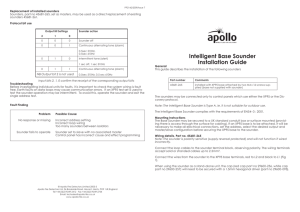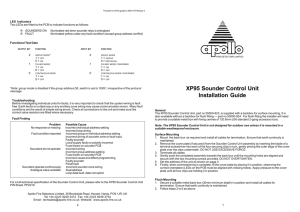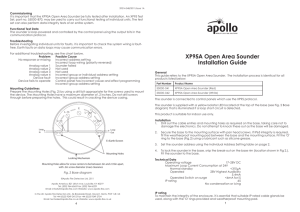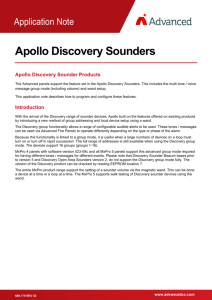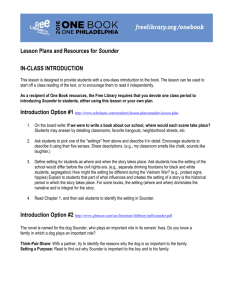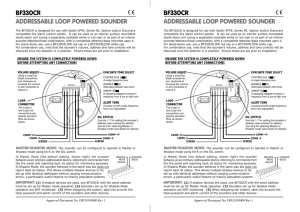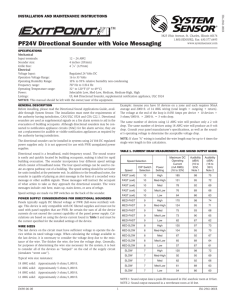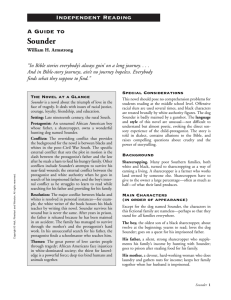Furuno Sounder Module (v2 update) Installation and
advertisement
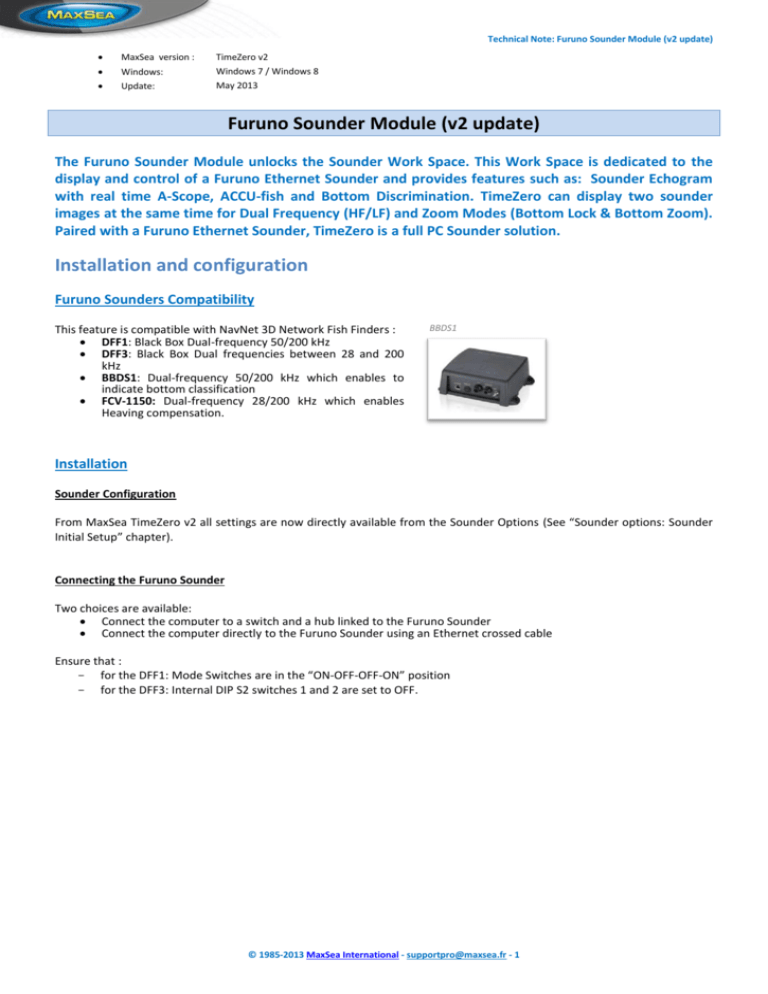
Technical Note: Furuno Sounder Module (v2 update) MaxSea version : TimeZero v2 Windows: Windows 7 / Windows 8 Update: May 2013 Furuno Sounder Module (v2 update) The Furuno Sounder Module unlocks the Sounder Work Space. This Work Space is dedicated to the display and control of a Furuno Ethernet Sounder and provides features such as: Sounder Echogram with real time A-Scope, ACCU-fish and Bottom Discrimination. TimeZero can display two sounder images at the same time for Dual Frequency (HF/LF) and Zoom Modes (Bottom Lock & Bottom Zoom). Paired with a Furuno Ethernet Sounder, TimeZero is a full PC Sounder solution. Installation and configuration Furuno Sounders Compatibility This feature is compatible with NavNet 3D Network Fish Finders : DFF1: Black Box Dual-frequency 50/200 kHz DFF3: Black Box Dual frequencies between 28 and 200 kHz BBDS1: Dual-frequency 50/200 kHz which enables to indicate bottom classification FCV-1150: Dual-frequency 28/200 kHz which enables Heaving compensation. BBDS1 Installation Sounder Configuration From MaxSea TimeZero v2 all settings are now directly available from the Sounder Options (See “Sounder options: Sounder Initial Setup” chapter). Connecting the Furuno Sounder Two choices are available: Connect the computer to a switch and a hub linked to the Furuno Sounder Connect the computer directly to the Furuno Sounder using an Ethernet crossed cable Ensure that : - for the DFF1: Mode Switches are in the “ON-OFF-OFF-ON” position - for the DFF3: Internal DIP S2 switches 1 and 2 are set to OFF. © 1985-2013 MaxSea International - supportpro@maxsea.fr - 1 Technical Note: Furuno Sounder Module (v2 update) In the computer If the PC and sounder are connected to NavNet3D equipment, the MFD set as Master will act as a DHCP server and will automatically perform the network configuration of all the other equipment on the network, including the computer. Just be sure that this one is configured as an Automatic IP Address. If the sounder is connected directly to the computer you have to set the IP address manually. To change TCP/IP settings, follow these steps: Windows 7/Windows 8 - Type “ncpa.cpl” in the “Search Programs and Files” box Press [Enter] - Right-click on the network adapter that the sounder will be plugged into. This will display “Local Area Connection” Then click Properties Select “Internet Protocol (TCP/IP)” or “Internet Protocol Version 4 (TCP/IPv4)” from the list. - In the General tab of the Internet Protocol Properties window: - Select “Use the following IP address” - IP Address: 172.31.3.100 - Subnet mask: 255.255.0.0 - Click OK © 1985-2013 MaxSea International - supportpro@maxsea.fr - 2 Technical Note: Furuno Sounder Module (v2 update) Check the IP address To check if the computer has a valid IP address, use the IPCONFIG command. In the “Search Programs and Files box : - Type “cmd” - Press Enter - Type “ipconfig” in the command editor. The 'ipconfig' displays the IP address, the network subnet mask and the Internet/network gateway address if one is set for that network. Ensure the IP is compatible with the NavNet network (172.31.X.X) Make sure also that the subnet Mask is 255.255.0.0 Ping the source sounder To check the connection between the computer and the Sounder, ping the sounder IP address. For default sounder configuration type in the command editor > ping 172.31.92.1 Host Name and corresponding IP address table Host Name SOUNDER SOUNDER1 SOUNDER2 SOUNDER3 SOUNDER4 SOUNDER5 SOUNDER6 SOUNDER7 SOUNDER8 SOUNDER9 IP Address 172.031.092.001 172.031.092.011 172.031.092.012 172.031.092.013 172.031.092.014 172.031.092.015 172.031.092.016 172.031.092.017 172.031.092.018 172.031.092.019 Caution! Never put the “0” before one of the IP address numbers (x) 172.x31.x92.xx1 C:\>ping 172.031.92.1 Pinging 172.25.92.1 with 32 bytes of data: PING: transmit failed. General failure. For example: if you type 172.031.92.1 the system will ping in reality 172.25.92.1 which will result in an error message. C:\>ping 172.31.092.1 Ping request could not find host 172.31.092.1. Please check the name and try again. © 1985-2013 MaxSea International - supportpro@maxsea.fr - 3 Technical Note: Furuno Sounder Module (v2 update) Sounder Work Space This Work Space is dedicated to the display and control of a Furuno Ethernet Sounder. The Sounder can be directly connected (using an Ethernet Cable) to MaxSea TimeZero enabling the following features: Sounder Work Space overview Sounder Echogram display of the various Sounder modes, display and Control adjustment A-Scope display Detection of fish (ACCU-Fish) Bottom Discrimination Display (BBDS1 only) Echogram display The Sounder workspace will propose you a full screen single frequency echogram display. Display and sounder settings can be adjusted as shown below. Depth Range Display Mode indicator (HF, LF, BZ, BL) Horizontal scale : time elapsed Vertical scale : Depth Historic Data TimeZero stores the data received in the past 3 minutes (approximately). You can then easily go back and identify echoes that seem interesting. To display historic data, you can scroll the image backwards using the "Pan" tool Note: Time is displayed in the Horizontal scale. You can quickly go back to the actual boat position by clicking the “Center On” tool © 1985-2013 MaxSea International - supportpro@maxsea.fr - 4 Technical Note: Furuno Sounder Module (v2 update) Geo-localisation The “Sounder and Nav” Work Space can be used to display side by side the Plotter and the Sounder. Cursor geolocation Moving the cursor across the Sounder image will automatically display a red cross cursor on the Chart allowing you to geolocate any Sounder “sweeps”. Add a mark Double click on the sounder space to automatically create a Mark on the chart space, making it easier to go back to something that was spotted on the Sounder. Add event (PLOT only) By clicking on the “Event” tool in the sounder space, you can automatically create a Mark on the chart space at the current boat position. Sounder Mode To change the display mode click the "Sounder Mode" button from the Sounder Work Space ribbon and select the options: HF : Higher frequencies (200 kHz) The higher the frequency of the ultrasonic signal, the better the resolution. For this reason the 200 kHz frequency is ideal for detailed observation of fish schools. LF: Lower frequencies (50 kHz) The 50 kHz frequency is useful for general detection and judging bottom condition. When acoustic energy travels through the water, the frequency determines how deep it will travel and also the level of definition you can expect to see after it has bounced off an object below. © 1985-2013 MaxSea International - supportpro@maxsea.fr - 5 Technical Note: Furuno Sounder Module (v2 update) Single frequency display The single frequency display shows either the low-frequency or high-frequency picture on the whole screen. Select a frequency LF or HF according to your purpose. Note: You can switch the frequency between HF and LF by clicking the sounder scale box at the bottom left-hand corner of the sounder display. Dual frequency display The dual frequency display provides both low and high frequency pictures. Use the dual frequency display to compare the same picture with two different sounder frequencies. Note: You can switch the between LF/HF frequency displays by clicking on the sounder scale box at the bottom left-hand corner of the sounder display. Bottom Zoom Mode The “Bottom Zoom” display expands the bottom and the fish near the bottom according to the “Zoom Range Span” in “Sounder option”. This mode only changes the zoom scale (enlargement of a portion of the echo) and is very useful in determining the density of the bottom: A short echo tail normally indicates a soft bottom (sand bottom, etc.). A long echo tail indicates a hard bottom. Note: "Bottom Zoom" Mode operates in dual display with HF/LF frequency display. © 1985-2013 MaxSea International - supportpro@maxsea.fr - 6 Technical Note: Furuno Sounder Module (v2 update) Bottom Lock Mode The bottom lock display provides a normal picture on the right half and a 7 to 400 feet (2 to 120 meter) wide layer in contact with the bottom is expanded on the left half, according to the “Bottom Lock Range Span” selected from the “Sounder Option” menu. This display helps you separate the fish near the bottom from the very bottom. The bottom lock mode allows the undulating bottom to be displayed on the screen as flat, while fish above it are shown clearly. Auto Range The Range can be adjusted manually or automatically. Automatic adjustment is useful when you are preoccupied with other tasks and do not have the time to adjust the display. The range is automatically changed to keep the bottom echo on the lower half of the screen. - Check the box to activate the "Auto Range" mode. Manual Adjustment When the automatic mode is disabled, Range can be adjusted using the R+ and R- buttons from the toolbar. Clicking on R+ changes the scale to higher values (The sounder will allow deeper vision) Clicking on R- changes the scale to lower values. (The sounder will provide a "less deep" view) The mouse wheel can also be used to manually change the display scale. Note: The range cannot be changed in the “Auto Range” mode or the bottom discrimination display. Day Backgound Day/Dusk/Night/Automatic Adjusts the sounder screen background according to the ambient luminosity (No interaction with the sounder itself) Default setting : Day Range of choice : Day, Dusk, Night, Automatic Dusk Backgound When set to Automatic, TimeZero will automatically switch modes according to your local sunset and sunrise time. Note: Background color can be set from the sounder options. © 1985-2013 MaxSea International - supportpro@maxsea.fr - 7 Technical Note: Furuno Sounder Module (v2 update) Transmit The Transmit option allows to turn on or off (Stand-by) the sounder transmission. - Check the box to turn on. Sounder Display To add items to the Sounder window, click on the “Sounder Display” button in the work space ribbon, and then select items to add: A-Scope A-scope, display on the right of the screen, show echoes at each transmission with amplitudes and tone proportional to their intensities. It is useful for estimating the kind of fish school and bottom composition. Weak reflection (Fish or noise) Strong reflection (Fish) Strong reflection (bottom) © 1985-2013 MaxSea International - supportpro@maxsea.fr - 8 Technical Note: Furuno Sounder Module (v2 update) ACCU-fish “ACCU-fish” display Click on the “Sounder Display” button in the ribbon to go down the menu and set the “ACCU-Fish” display: Choose the “ACCU-Fish” icon to show or hide information in the echo-gram space Choose the “ACCU-Fish color” item to change the color of the display Choose the “ACCU-Fish icon” item to change the icon symbol The ACCU-Fish feature estimates the length of each fish and shows a fish symbol and depth value or fish length. Note: The information presented by this feature is intended for reference purposes only; it is not a completely accurate measurement of fish length. This feature requires the appropriate transducer and either Network Sounder BBDS1, DFF1 or DFF3. Both high and low frequencies bouncing back from the center of the transducer beam are used to calculate fish length, when ACCU-Fish is enabled; the sounder will work in dual frequency mode. Note: In the case of a fish school, echoes overlap one another, so the margin of error will be greater. Fish geolocation When the “Sounder and Nav” Work Space is used to display the Plotter and Sounder side by side, every ACCU-Fish icon will automatically appear geolocated on the chart. Note: Fish icons fade away after a length of time that can be set up by the user. © 1985-2013 MaxSea International - supportpro@maxsea.fr - 9 Technical Note: Furuno Sounder Module (v2 update) Bottom Discrimination Display (with BBDS1 only) The bottom discrimination windows can be displayed from the Sounder workspace. The display is available in all screen divisions, single or dual frequency mode and occupies the bottom 1/6 of the screen. Click on the “Sounder Display” button in the ribbon to roll down the menu and choose "Bottom". For more information consult the Technical Note: New Bottom Hardness and Classification Feature with BBDS1 http://download.maxsea.com/Commercial/technical_notes/TN_EN_New_Bottom_Hardness_and_Classification_Feature_with_BBDS1.pdf Sounder Adjustment The gain may be adjusted automatically (Fishing or Cruising) or manually. Click on the “Sounder Adjustment” button in the ribbon to roll down the menu to choose the appropriate Gain setting among Auto Fishing, Auto cruising or Manual mode. Automatic Settings The HF and LF Gain controls adjust the sensitivity of the receiver. In automatic mode, the gain will automatically allow to display the bottom echo in a reddish brown colour. There are two automatic modes available in MaxSea: Auto Fishing Auto Fishing Select this mode to clearly display weaker echoes when searching for fish schools. Auto Cruising (Route Auto) Select this mode to clearly display stronger echoes (for example, the bottom) and suppress weak echoes. Use it for general cruising. © 1985-2013 MaxSea International - supportpro@maxsea.fr - 10 Auto Cruising Technical Note: Furuno Sounder Module (v2 update) Manual Mode Select this mode to manually adjust HF or LF gain. The setting range is 0 to 100. To adjust the value: - Click on “Sounder Adjustment” button - From the drop down menu, click on the slider directly or use the mouse wheel (with the cursor over the slider). GAIN LF : 0% Note: Use a higher setting for deep waters and a lower setting for shallow waters. In any case, adjust the controls so that a slight amount of noise remains on the screen. Interference Rejection Interferences from other fish finders and electrical equipment can introduce artifacts (or noise) on the sounder screen. Click on the Sounder Adjustment Ribbon menu and choose between Auto/ Off / high or Low. © 1985-2013 MaxSea International - supportpro@maxsea.fr - 11 GAIN LF : 100% Technical Note: Furuno Sounder Module (v2 update) Sounder options The Sounder options allow you to configure various advanced Sounder Setup and Display preferences. These Sounder Options will only be available if you have unlocked the Furuno Sounder Plus Pack. To change the settings: - Click the "MaxSea" Menu - Click on "Options ..." - Select "Sounder". You can also access the options by selecting "Options ..." from dropdown menus on buttons in the Sounder Work space ribbon. Sounder options Fish Finder Source Allows you to choose the sounder to be used. To Select: - From the drop-down list select a source if several devices have been detected. Day Background Color Determines the sounder screen background colour in day mode. To change the value: - From the drop-down list select the required colour: Default value: White Range of choice: White, Light blue, Black, Dark blue Night Background Color Determines the sounder background screen colour in night mode. To change the value: - From the drop-down list select the required colour: Default value: Dark blue Range of choice: Black, Dark blue Echo Color Levels Allows you to choose to display the echo presentation in colours, with colour assignment dependent on the strength of the returned echo. To change the value: - From the drop-down list select the required colour level: Default value: 64 colours Range of choice: 8, 16 or 64 © 1985-2013 MaxSea International - supportpro@maxsea.fr - 12 Technical Note: Furuno Sounder Module (v2 update) A-Scope Peak Hold Allows to hold the echo return in the A-Scope for a couple of seconds. Activation: - Check the box to activate. Zoom Reference Lines This option allows to Show or hide the zoom marker lines that appear on the right part of the display when working in “Bottom Zoom” or ‘Bottom Lock” modes. Activation: - Check the box to display marker lines. High Resolution Shows the graphical echo in high resolution and improves its display. Activate to get higher screen resolution and greater detail When disabled, smoother echoes are displayed, however the screen resolution is lower. To apply: - Check the box to display in high resolution. Picture Advance The picture advance speed controls how quickly the vertical scan lines move across the screen. A fast advance speed expands the size of a school of fish horizontally on the screen. A slow advance speed shortens the school of fish. Use a fast advance speed to see the bottom hardness. Use a slow advance speed to see a smoother bottom. Fast To change the value: - From the drop-down list select the required speed: Default value: 1 Range of choice: 4, 2, 1, ½, 1/4, 1/8, 1/16, Stop Range Shift The range shift functions let you select the depth you can see on the screen. This function is not available when “Auto Range” is active. To change the value: - Go to the "Range Shift" field - Type scale (value and unit) - Press [Enter] to confirm. You can also change the offset with the mouse: - Click on sounder echo display - While holding down the click, shift the image up or down - When the desired "Range" is reached release the mouse click. Note: This function is not available when “Auto Range” is active. © 1985-2013 MaxSea International - supportpro@maxsea.fr - 13 Slaow Technical Note: Furuno Sounder Module (v2 update) Bottom Range Shift Area Select the area where to show the bottom echo, when “Auto Range” is active. For example, setting 50% would place the bottom echo at a position equivalent to 50% from the top of the screen. To change the value - Move the cursor with the mouse - Or enter the desired value Default value: 75% Range of choice: from 15% to 85% Zoom Range Span Set up the height of the view of the bottom zoom observation without modifying the echo range. This allows you to zoom-in on a part of the echo. To change the value: - Go to the “Zoom Range Span” field - Type the required Range value (value and unit) - Press [Enter] to validate Note: Used in “Bottom Zoom” mode only. Bottom Lock Range Span To set up the height of the Bottom lock observation view. The Echo range is simultaneously modified. To change the value: - From “Bottom Lock Range Span” field - Type the required Range value (value and unit) - Press [Enter] to validate Note: Used in “Bottom Lock” mode only. ACCU-fish Info Fish information is displayed in either depth or size of the detected fish. It is displayed below the echo at the detection location. To select the value: - From the drop-down list select the required information: Default value : Depth Range of choice : Depth or Fish size Fish symbol Off ACCU-Fish Symbols This option determines the fish symbol used to mark detected fish. To select the symbol: - From the drop-down list select the required symbol: Default value: Solid Range of choice: Off, Solid, Stripped © 1985-2013 MaxSea International - supportpro@maxsea.fr - 14 Solid Technical Note: Furuno Sounder Module (v2 update) Stripped Stripped & red Note: This choice is also available directly from the "Sounder Display" button. ACCU-Fish Size Correction The fish size shown on the screen can be different from the true size. If the size is wrong, add an offset to the measured value to get a more accurate indication on the screen. To adjust the size of fish information: - Move the slider to the desired value : Default value: 0% Range of choice: From -80% to 100% Setting + 100 + 50 - 50 - 65 - 75 - 80 Revised size Two times 1,5 times 1/2 1/3 1/4 1/5 Heaving Correction (MFD Required) When the ship is in rough seas, the bottom echo and the echoes from fish are not stable, because the distance to the bottom changes. To remove this problem, the satellite compass sends pitch and roll data to the fish finder to adjust the TX and RX beams. This function requires a FURUNO Satellite Compass. Note: MFD Required on the TimeZero NavNet Network. Interference Rejection Interference from other fish finders and electrical equipment appears on the screen as shown in the illustration. When these types of interference appear on the screen, use the interference rejector to reduce the interference. To Reduce Interference: - From the drop-down list select the required value: Default value: Auto Range of choices: Off, Low, Medium, High, Auto Note: Turn off the interference rejector when there is no interference, so that you do not erase weak echoes. Clutter Low intensity “spots” of noise appear over most of the screen like in the illustration shown below. These spots are caused by sediment in the water or noise. Transition 0 to 100 To reduce this type of noise. - Move the slider to the desired value: Default value: 0 Range of choice: From 0 to 100 © 1985-2013 MaxSea International - supportpro@maxsea.fr - 15 Technical Note: Furuno Sounder Module (v2 update) Colour Erase: Increase this setting to remove weak sounder return from the screen (remove the colours that are used to display weak echoes). To adjust this value: - Move the slider to the desired value : Default value: 0 Range of choice: From 0 to 50 Color Erase = 0 White Marker Off White Marker: Color Erase = 50 White Marker Color8 Allows the user to change one colour of the sounder colour palette to white. This feature is useful to accentuate echoes of a specific strength. To adjust this value: - From the drop-down list select the required value: Default value : Off Range of choice : Off, color 1 to color 8 White Edge Check this option to display a white line over the bottom. This can be helpful to distinguish fish that are close to the bottom (they would appear above the white line). TVG HF et LF : (Time Varying Gain) This compensates for propagation attenuation of the ultrasonic waves. It does this by equalizing echo presentation so that fish schools of the same size appear in the same density in both shallow and deep waters. In addition, it reduces surface noise. To Adjust TVG (can be set separately for HF or LF) - Move the slider to the desired value : Default value : 5 Range of choice : 0 to 9 Note: if the TVG level is set too high short range echoes may not be displayed. Illustration: TVG LF = 0 TVG LF = 5 TVG HF = 0 TVG HF = 9 Transmit Rate Auto Automatically sets the transmit rate according to the ship’s speed, and it is inoperative when there is no speed data. In normal use, leave this setting at the maximum value. Activation: - Check the box to turn on. © 1985-2013 MaxSea International - supportpro@maxsea.fr - 16 Technical Note: Furuno Sounder Module (v2 update) Transmit Rate Manual Change the TX pulse repetition rate to 21 levels to prevent the second reflection echo. Use 21 (highest power) in normal use. Lower the TX rate in shallow waters to prevent the second reflection echo. To adjust the Transmit Rate - Move the slider to the desired value: Default value: 21 Range of choice: from 0 to 21 Sounder Transmit This transmit option allows you to turn on or off (Stand-by) the sounder transmission. - Check the box to turn on. Fish Finder Alarms Two types of fish alarms set off audio and visual alarms to tell you that there are fish echoes in the area you selected. These alarms are called “Fish Alarm” and “Fish Alarm for Bottom Lock”. “Fish Alarm” The “Fish Alarm” function tells you when an echo above some (adjustable) strength is within the alarm range you have chosen. - Check the “Fish Alarm” box to activate the alarm when detecting fish. - Adjust the Minimum and Maximum alarm range from the “Minimum Range Values and Maximum Range Values” fields. “Fish Alarm for Bottom Lock” The “Fish Alarm for Bottom Lock” function tells you when fish are within a certain distance from the bottom. The “bottom lock” display must be active to use this alarm. - Check the “Fish Alarm for Bottom Lock” box to set off an alarm when fish are detected. - Adjust the Minimum and Maximum alarms for bottom lock range from the “Range Minimum Values and Range Maximum Values” fields. “Fish Alarm level” You can select the strength of echoes that trigger the fish alarms. To adjust this level: - From the drop-down list select the desired value: Default value : Medium Range of choice : Low, Medium, High © 1985-2013 MaxSea International - supportpro@maxsea.fr - 17 Technical Note: Furuno Sounder Module (v2 update) Sounder Initial Setup “Zero Line Rejection”: Check this option to mask the echoes near the top of the screen (that are caused by the transducer itself). Use the "Zero Line Range" settings to increase or decrease the height of the mask. “Transducer Draft”: Sets the transducer’s draft, to show the depth between the sea surface and the bottom (rather than from boat to bottom). “Salt Water”: The rate of echo transmission is different in salt water. Check this option if you navigate at sea. “Fish Finder Source”: Click on this button to display all sounders connected to the computer. Clicking on one sounder name allows you to select the sounder you want to use in the software. “Transducer Setup”: Click the “Transducer Setup” button to display and set advanced transducer parameters. - If the Model is chosen, set the model number appropriate to the High frequencies and the low frequencies. - If Manual is chosen, adjust the higher frequency and the lower frequency. “Motion Sensor” (MFD required): allows the user to define all transducer positions from the Bow and Stern or from Up and Down or from Port and Starboard for each frequency HF/LF. “External KP“: Synchronises transmission with other echo sounders. Select EXTERNAL KP to synchronise transmission. © 1985-2013 MaxSea International - supportpro@maxsea.fr - 18 Technical Note: Furuno Sounder Module (v2 update) “Bottom level HF and LF“: To Adjust the bottom level value in HF or LF display. “Gain Offset HF and LF“: To Adjust the Gain value when working in Manual mode. Normally, set the gain to the point where excessive noise does not appear on the screen. Use a higher gain setting for greater depths and a lower setting for shallow waters. “Auto Gain Offset HF and LF”: To Adjust the Gain value when working in Automatic mode. DFF3 Sounder Initial Setup - “STC HF (LF)”: Delete unnecessary echoes (plankton, air pockets, etc.) near the surface that hide the fish. The settings range is from 0 to 10, and 0 is off. 10 deletes unnecessary echoes from the surface to approximately 16 ft depth. Note: Make sure you do not use more STC than necessary, because you can erase the small echoes near the surface. “Frequency Adjust HF (LF)”: You can adjust the TX frequency of both low- and high-frequency transducers. Use this feature when your fish finder and another fish finder operate on the same frequency, causing interference. Change the frequency of your transducer by enough percentage points to remove the interference. “TX Pulse HF (LF)”: The pulse length is automatically set according to range and shift. Use a short pulse for better resolution and a long pulse when detection range is important. To improve resolution on zoom displays, use [Short 1] or [Short 2]. - [Short 1] improves the detection resolution, but the detection range is shorter than with [Std] (pulse length is 1/4 of [Std]). [Short 2] raises the detection resolution, however detection range is shorter (pulse length is about 1/2 of [Std]) than [Std]. [Std] is the standard pulse length, and is suitable for general use. [Long] increases the detection range but lowers the resolution (about 1/2 compared to the [Std] pulse length. - - “RX Band HF (LF)”: The RX bandwidth is automatically set according to pulse length. To decrease noise, select [Narrow]. For better resolution, select [Wide]. “Temperature Port”: Select the data source for water temperature. [MJ]: The water temperature data from the water temperature/speed sensor [Low Frequency]: The low frequency measured water temperature [High Frequency]: The high frequency measured water temperature “Set Hardware to Factory Default”: Click this button to restore sounder factory default settings. © 1985-2013 MaxSea International - supportpro@maxsea.fr - 19
